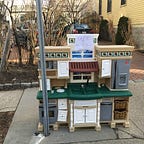Expectations for mass transit have changed and the T should too.
If you hadn’t heard, the MBTA is an old system. We like to brag we’re the oldest subway in the US. The city of Boston grew around us. And we grew around the city. More than 150 years ago some guy laid some rail, hooked a trolley to the back of a horse, and collected a dime to get from Central Square to Bowdoin Square. Today we call that the Red Line, and that 150 year old route has the highest ridership in the system.
The basic user interaction with mass transit doesn’t change a whole lot for the next 140+ years. You look in the newspaper for a schedule (maps were a big breakthrough; seriously), go to the corner, look down the street and see if the next bus or trolley is coming. Or go to the subway station and count how many passengers are on the platform to see how soon the next train will arrive.
10 years ago you could still use a token to use the T. You couldn’t type in your origin and destination and have 3 different route options presented to you on a device in your pocket. You couldn’t get info on where your next bus was in real time. Or an alert if it was stuck in traffic. Or know when the next Red Line train was coming when you were on the platform.
1 year ago you didn’t know when the next green line train was coming.
We changed.
Yay for us. Anyone who takes the T knows real-time information and ubiquitous search and discovery sounds small, but it totally changes the experience, in a measurable fashion. We released data early and often. It is not enough.
The truth is that there are a lot of hard things the T has to fix including but not limited to signals the predate ww1 and red line cars that could have been featured in a Bryan Adams song. We have a backlog to bring the physical plant into state of good repair with a cost that begins with a B. And we as riders of the system know that the people who take 1.4 million daily trips expect this to be fixed now.
Those projects take not just money but time.
We have to make the needed investments, but it is not the only thing we need to do.
We can’t just invest in hardware. We need to focus on software too — on building the platform that allows us to grow and change and improve our service as fast as people expect us to. And in doing so we can improve the daily experience of taking the T now.
- By providing more timely accurate and needed customer information (like: is the bus going to be packed?).
- By providing a single account with the T that knows where you use the system and gets you real time info when you need it and reloads your card automatically.
- By upgrading the fare system so you can pay with your phone at all doors of any bus or train.
- By fixing a website used by 1 in 10 of our customers each day.
- By opening up APIs so that you can do that all on Transit or CityMapper or OpenMBTA or whatever App comes next.
- By making sure we’re collecting, storing, and disseminating all this data so that we can improve where and when and how often we provide service.
- By providing tools to allow the people who work at the T to run the buses and trains better, so they come more regularly and wait times are lower.
- By building off and open sourcing our work so transit agencies across the Commonwealth, the country, and the world can share in the technology we’re building to improve their systems too.
It’s a big mission and lots of riders need us to succeed.
We’re building with the best of the Boston tech scene — our team has worked at Kayak and CoachUp and Localytics and Zipcar and Bridj.
The T built Boston, and it’s time for Boston tech to help build the next generation experience at the T.
